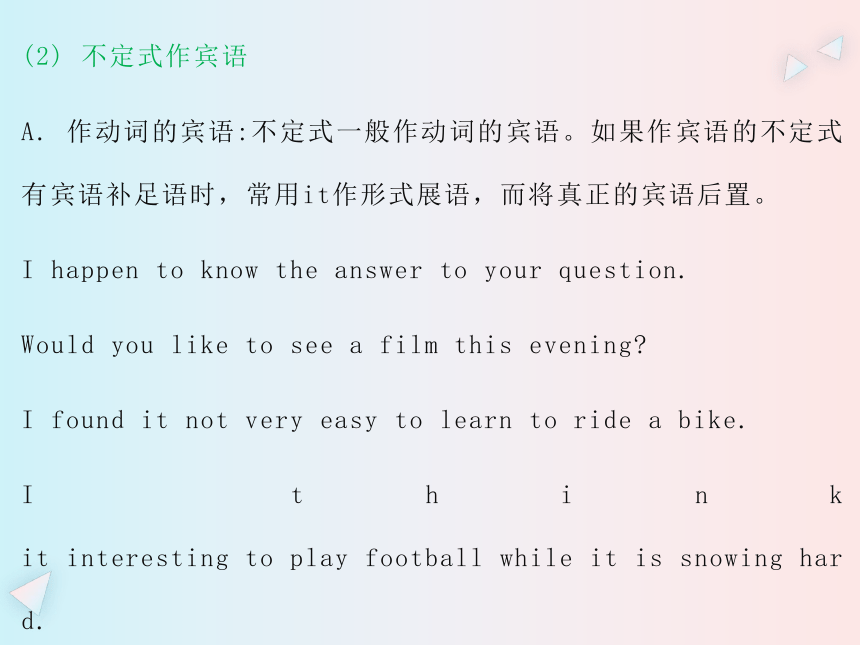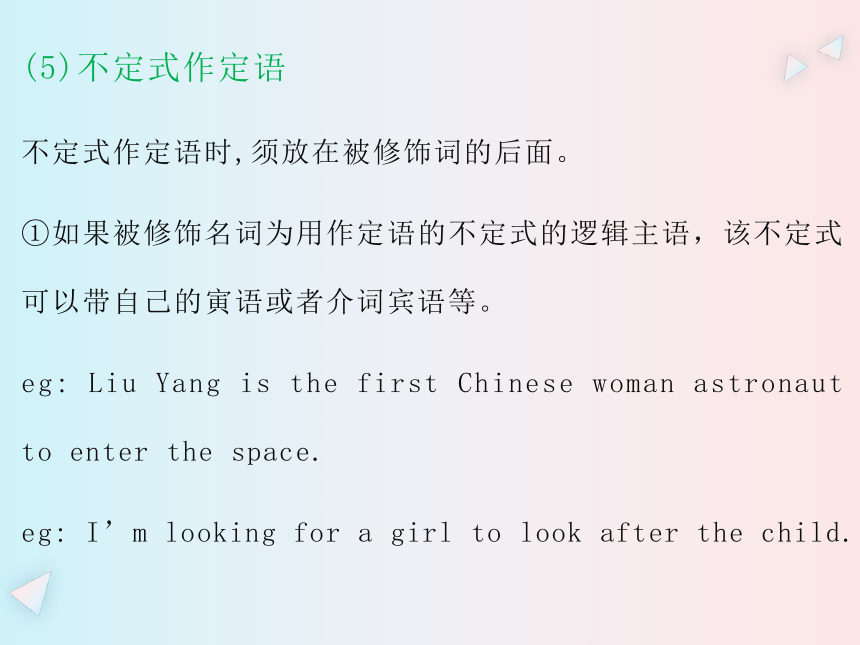初中英语语法大全——非谓语动词(共24张PPT)
文档属性
| 名称 | 初中英语语法大全——非谓语动词(共24张PPT) |  | |
| 格式 | ppt | ||
| 文件大小 | 3.0MB | ||
| 资源类型 | 教案 | ||
| 版本资源 | 通用版 | ||
| 科目 | 英语 | ||
| 更新时间 | 2022-04-10 10:28:15 | ||
图片预览









文档简介
(共24张PPT)
初中英语语法大全
非谓语动词
非谓语动词是指动词在句中不能独立作谓语,但同时保留动词某些特征的动词形式。包括不定式、动名词和分词(现在分词、过去分词)三种。它们没有人称和数的变化,但可以有自己的逻辑主语、宾语、状语等。
一、不定式
不定式的全称是“动词不定式”,是一种非限制动词。不定式具有动词的特征同时也有名词、形容词和副词的特征。动词不定式没有人称和数的变化,在句子中不能作谓语。
1. 不定式的构成
动词不定式的基本构成是"to+动词原形”有时可省路不定式符号to。否定形式是"not to+动词原形”。
Jacks teacher asked him to tum off the lights after class.
You’d better finish your work today.
She pretended not to see me when I passed by.
2. 不定式的句法功能
(1) 不定式作主语
不定式作主语相当于名词或代词的作用。用作主语的动词不定式通常表示一个具体的,特定的行为,其谓语动词用第三人称单数形式。不定式作主语通常用作形式主语,而将不定式置于句末。
To know something about English is one thing; to master English is quite another.
To learn English well is very difficult. = It is difficult to learn Chinese well.
(2) 不定式作宾语
A. 作动词的宾语:不定式一般作动词的宾语。如果作宾语的不定式有宾语补足语时,常用it作形式展语,而将真正的宾语后置。
I happen to know the answer to your question.
Would you like to see a film this evening
I found it not very easy to learn to ride a bike.
I think it interesting to play football while it is snowing hard.
(3)不定式作表语
不定式可以跟在系动词后作表语,表示主语的具体内容、目的等。不定式作表语通常可以跟主语进行位置互换。
eg: My job is to keep the goal.
eg: His dream is to be a doctor.
(4)不定式作宾语补足语
eg: Lucy asked him to turn down the radio.
eg: Mr. White persuaded Tom not to smoke any more.
eg: I sat near her and heard her sing the new song.
eg: The peaceful music in the CD made the students feel relax.
(5)不定式作定语
不定式作定语时,须放在被修饰词的后面。
①如果被修饰名词为用作定语的不定式的逻辑主语,该不定式可以带自己的寅语或者介词宾语等。
eg: Liu Yang is the first Chinese woman astronaut to enter the space.
eg: I’m looking for a girl to look after the child.
②如果被修饰名闻为用作定语的不定式的逻辑宾语,而该不定式又为及物动词时,其后不能再跟任何宾语。
eg: Why don't you go out to play, Rosa --- I’m afraid I can't. I have much homework to do.
eg: The important thing is to get some work to do.
③如果不定式是不及物动词,且与所修饰词是逻辑上的动实关系时,要在不定式后加上相应的介词。
They could not find a place to live in.
eg: That girl has nothing to worry about.
(6)不定式作状语
①不定式作状语主要表示目的等。表示目的时常位于句首,表示原因和结果时常位于句尾。
eg: To arrive there on time, I got up one hour earlier than usual.
eg: In ancient China, food was stored with ice to keep it fresh.
②可在作目的状语的不定式前加上in order或so as以突出或强调的。但so as to do不能置于句首。在作结果状语的不定式前加上only表示意料之外的结果。
eg: In order to keep warm, we shut all the windows.
eg: John came home only to find that somebody had forced his door open.
3.“疑问词+不定式”结构
who(m), what, which等疑问代词和when, where, how等疑问副词放在不定式前,便构成了“疑问词+不定式”当于一个名词,常在句中作主语、表语、宾语(尤其是介词后的宾语等)。
eg: How to solve the problem is very important.
eg: The question is who to turn to.
eg: The teacher is telling the students what to do.
eg: My teacher gave me lots of advice on how to make friends.
4. 不定式符号to的省略
(1) 某些固定结构或者固定搭配中需要省略不定式符号to。
eg: You 'd better choose the activities which interest you.
eg: Why not go shopping with me
(2)动词help后接不定式作宾语或宽语补足语,to可有可无,但是当主语是表示物的名词或主语不能发出不定式所表示的动作时,需要加上to。
eg: Will you help me (to) find my pen
eg: Your rich experience will help you to find a good job.
二、动名词
动名词是由动词原形+ing”构成,既具有动词的特征,也具有名词的特征。在句中作主语、宾语、表语定语等,但不能作谓语。其否定形式为“not+动名词”。
1.作主语
动名词作主语-般表示经常性、习惯性的动作,有时也用it 作形式主语,而把动名词后置。动名词常常被看作是不可数名词,作主语时,谓语用第三人称单数形式。
eg:Taking a cold shower every morning does him good. 每天早晨洗个冷水澡对他有好处。
eg: Learning English all by yourself not so easy. 完全靠自己学英语不那么容易。
知识归纳
常用it作形式主语的句式
It is no use/ good doing.. 做...是没有用的不好的。
It is a waste of time doing...做..是浪费时间的。
It is useful/ enjoyable/ tiring doing... 做...是有用的/ 令人高兴的/累人的
2.作宾语
动名词可作短语动词的实语和介词的实语。
eg: Do you mind my closing the door 我把门关上你介意吗
eg: I look forward to receiving your letter soon. 我盼望尽快收到你的来信。
eg: I insist on him wearing a suit. 我坚持让他穿西装。
常接动名词作宾语的(短语)动词
enjoy喜欢 finish完成 practise练习
suggest建议 mind介意
avoid避免 admit承认 consider考虑
give up放弃 look forward to盼望
imagine想象 be busy忙于 put off推迟
feel like想要 be worth值得
can't help忍不住 be/get used to习惯于
keep (on)继续 be good at擅长
do well in擅长 think about考虑
3.作表语
动名词作表语多表示抽象性或习惯性的动作,一般说明 主语的内容。主语、表语的位置常可互换。
eg: My hobby is collecting stamps. =Collecting stamps is my hobby.我的爱好就是集邮。
eg: My son's favorite sport is playing ping-pong. =Playing ping-pong is my son's favorite sport.
我儿子最喜欢的运动就是打乒乓球。
4.作定语
动名词作定语位于被修饰词之前,表示被修饰词的用途。
eg: The old man needs a walking stick(=a stick for walking). 这位老人需要一根拐杖。
Let's buy a washing machine( a machine for washing). 我们买一台洗衣机吧。
She is reading in the reading room(=the room for reading). 她正在阅览室读书。
三、分词
1. 作表语
分词用作表语时已经完全形容词化了,可以被very, rather 等副词修饰。现在分词作表语通常说明主语的性质、特征;过去分词作表语通常说明主语的状态或感受。
eg: The result of the game is very surprising.
eg: We were greatly surprised at the news.
2. 作定语
作定语的分词具有形容词的性质。单个的分词作定语常放在神修饰词的前面;分词短语作定语常放在被修传词的后面。
I have got a running nose.
He is a retired worker.
Do you know the id sanding under the tee
Who were the guests invited to your party last night
3. 作状语
分词在句中可作时间状语原因状语结果状语、条件状语、方式状语或伴随状语等。
eg: Arriving home, he showed me a large bright clean room.
eg: Frightened by the noise outside, the little girl dared not sleep in her bedroom.
初中英语语法大全
非谓语动词
非谓语动词是指动词在句中不能独立作谓语,但同时保留动词某些特征的动词形式。包括不定式、动名词和分词(现在分词、过去分词)三种。它们没有人称和数的变化,但可以有自己的逻辑主语、宾语、状语等。
一、不定式
不定式的全称是“动词不定式”,是一种非限制动词。不定式具有动词的特征同时也有名词、形容词和副词的特征。动词不定式没有人称和数的变化,在句子中不能作谓语。
1. 不定式的构成
动词不定式的基本构成是"to+动词原形”有时可省路不定式符号to。否定形式是"not to+动词原形”。
Jacks teacher asked him to tum off the lights after class.
You’d better finish your work today.
She pretended not to see me when I passed by.
2. 不定式的句法功能
(1) 不定式作主语
不定式作主语相当于名词或代词的作用。用作主语的动词不定式通常表示一个具体的,特定的行为,其谓语动词用第三人称单数形式。不定式作主语通常用作形式主语,而将不定式置于句末。
To know something about English is one thing; to master English is quite another.
To learn English well is very difficult. = It is difficult to learn Chinese well.
(2) 不定式作宾语
A. 作动词的宾语:不定式一般作动词的宾语。如果作宾语的不定式有宾语补足语时,常用it作形式展语,而将真正的宾语后置。
I happen to know the answer to your question.
Would you like to see a film this evening
I found it not very easy to learn to ride a bike.
I think it interesting to play football while it is snowing hard.
(3)不定式作表语
不定式可以跟在系动词后作表语,表示主语的具体内容、目的等。不定式作表语通常可以跟主语进行位置互换。
eg: My job is to keep the goal.
eg: His dream is to be a doctor.
(4)不定式作宾语补足语
eg: Lucy asked him to turn down the radio.
eg: Mr. White persuaded Tom not to smoke any more.
eg: I sat near her and heard her sing the new song.
eg: The peaceful music in the CD made the students feel relax.
(5)不定式作定语
不定式作定语时,须放在被修饰词的后面。
①如果被修饰名词为用作定语的不定式的逻辑主语,该不定式可以带自己的寅语或者介词宾语等。
eg: Liu Yang is the first Chinese woman astronaut to enter the space.
eg: I’m looking for a girl to look after the child.
②如果被修饰名闻为用作定语的不定式的逻辑宾语,而该不定式又为及物动词时,其后不能再跟任何宾语。
eg: Why don't you go out to play, Rosa --- I’m afraid I can't. I have much homework to do.
eg: The important thing is to get some work to do.
③如果不定式是不及物动词,且与所修饰词是逻辑上的动实关系时,要在不定式后加上相应的介词。
They could not find a place to live in.
eg: That girl has nothing to worry about.
(6)不定式作状语
①不定式作状语主要表示目的等。表示目的时常位于句首,表示原因和结果时常位于句尾。
eg: To arrive there on time, I got up one hour earlier than usual.
eg: In ancient China, food was stored with ice to keep it fresh.
②可在作目的状语的不定式前加上in order或so as以突出或强调的。但so as to do不能置于句首。在作结果状语的不定式前加上only表示意料之外的结果。
eg: In order to keep warm, we shut all the windows.
eg: John came home only to find that somebody had forced his door open.
3.“疑问词+不定式”结构
who(m), what, which等疑问代词和when, where, how等疑问副词放在不定式前,便构成了“疑问词+不定式”当于一个名词,常在句中作主语、表语、宾语(尤其是介词后的宾语等)。
eg: How to solve the problem is very important.
eg: The question is who to turn to.
eg: The teacher is telling the students what to do.
eg: My teacher gave me lots of advice on how to make friends.
4. 不定式符号to的省略
(1) 某些固定结构或者固定搭配中需要省略不定式符号to。
eg: You 'd better choose the activities which interest you.
eg: Why not go shopping with me
(2)动词help后接不定式作宾语或宽语补足语,to可有可无,但是当主语是表示物的名词或主语不能发出不定式所表示的动作时,需要加上to。
eg: Will you help me (to) find my pen
eg: Your rich experience will help you to find a good job.
二、动名词
动名词是由动词原形+ing”构成,既具有动词的特征,也具有名词的特征。在句中作主语、宾语、表语定语等,但不能作谓语。其否定形式为“not+动名词”。
1.作主语
动名词作主语-般表示经常性、习惯性的动作,有时也用it 作形式主语,而把动名词后置。动名词常常被看作是不可数名词,作主语时,谓语用第三人称单数形式。
eg:Taking a cold shower every morning does him good. 每天早晨洗个冷水澡对他有好处。
eg: Learning English all by yourself not so easy. 完全靠自己学英语不那么容易。
知识归纳
常用it作形式主语的句式
It is no use/ good doing.. 做...是没有用的不好的。
It is a waste of time doing...做..是浪费时间的。
It is useful/ enjoyable/ tiring doing... 做...是有用的/ 令人高兴的/累人的
2.作宾语
动名词可作短语动词的实语和介词的实语。
eg: Do you mind my closing the door 我把门关上你介意吗
eg: I look forward to receiving your letter soon. 我盼望尽快收到你的来信。
eg: I insist on him wearing a suit. 我坚持让他穿西装。
常接动名词作宾语的(短语)动词
enjoy喜欢 finish完成 practise练习
suggest建议 mind介意
avoid避免 admit承认 consider考虑
give up放弃 look forward to盼望
imagine想象 be busy忙于 put off推迟
feel like想要 be worth值得
can't help忍不住 be/get used to习惯于
keep (on)继续 be good at擅长
do well in擅长 think about考虑
3.作表语
动名词作表语多表示抽象性或习惯性的动作,一般说明 主语的内容。主语、表语的位置常可互换。
eg: My hobby is collecting stamps. =Collecting stamps is my hobby.我的爱好就是集邮。
eg: My son's favorite sport is playing ping-pong. =Playing ping-pong is my son's favorite sport.
我儿子最喜欢的运动就是打乒乓球。
4.作定语
动名词作定语位于被修饰词之前,表示被修饰词的用途。
eg: The old man needs a walking stick(=a stick for walking). 这位老人需要一根拐杖。
Let's buy a washing machine( a machine for washing). 我们买一台洗衣机吧。
She is reading in the reading room(=the room for reading). 她正在阅览室读书。
三、分词
1. 作表语
分词用作表语时已经完全形容词化了,可以被very, rather 等副词修饰。现在分词作表语通常说明主语的性质、特征;过去分词作表语通常说明主语的状态或感受。
eg: The result of the game is very surprising.
eg: We were greatly surprised at the news.
2. 作定语
作定语的分词具有形容词的性质。单个的分词作定语常放在神修饰词的前面;分词短语作定语常放在被修传词的后面。
I have got a running nose.
He is a retired worker.
Do you know the id sanding under the tee
Who were the guests invited to your party last night
3. 作状语
分词在句中可作时间状语原因状语结果状语、条件状语、方式状语或伴随状语等。
eg: Arriving home, he showed me a large bright clean room.
eg: Frightened by the noise outside, the little girl dared not sleep in her bedroom.
同课章节目录
- 词法
- 名词
- 动词和动词短语
- 动词语态
- 动词时态
- 助动词和情态动词
- 非谓语动词
- 冠词
- 代词
- 数词和量词
- 形容词副词及其比较等级
- 介词和介词短语
- 连词和感叹词
- 构词法
- 相似、相近词比较
- 句法
- 陈述句
- 一般疑问句和否定疑问句
- 特殊疑问句及选择疑问句
- 反意疑问句
- 存在句(There be句型)
- 宾语从句
- 定语从句
- 状语从句
- 主谓一致问题
- 简单句
- 并列句
- 复合句
- 主谓一致
- 主、表语从句
- 名词性从句
- 直接引语和间接引语
- 虚拟语气
- 感叹句
- 强调句
- 倒装句
- 祈使句
- 句子的成分
- 句子的分类
- 题型专区
- 单项选择部分
- 易错题
- 完形填空
- 阅读理解
- 词汇练习
- 听说训练
- 句型转换
- 补全对话
- 短文改错
- 翻译
- 书面表达
- 任务型阅读
- 语法填空
- 其他资料
